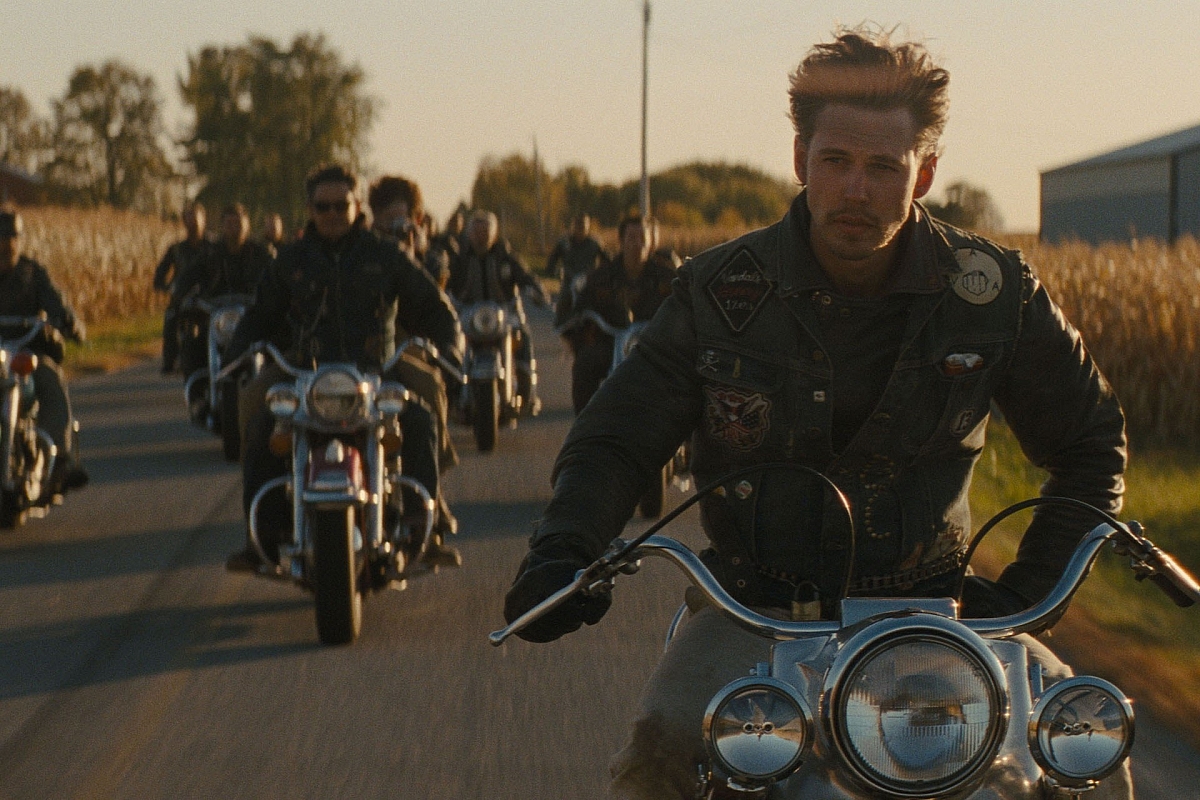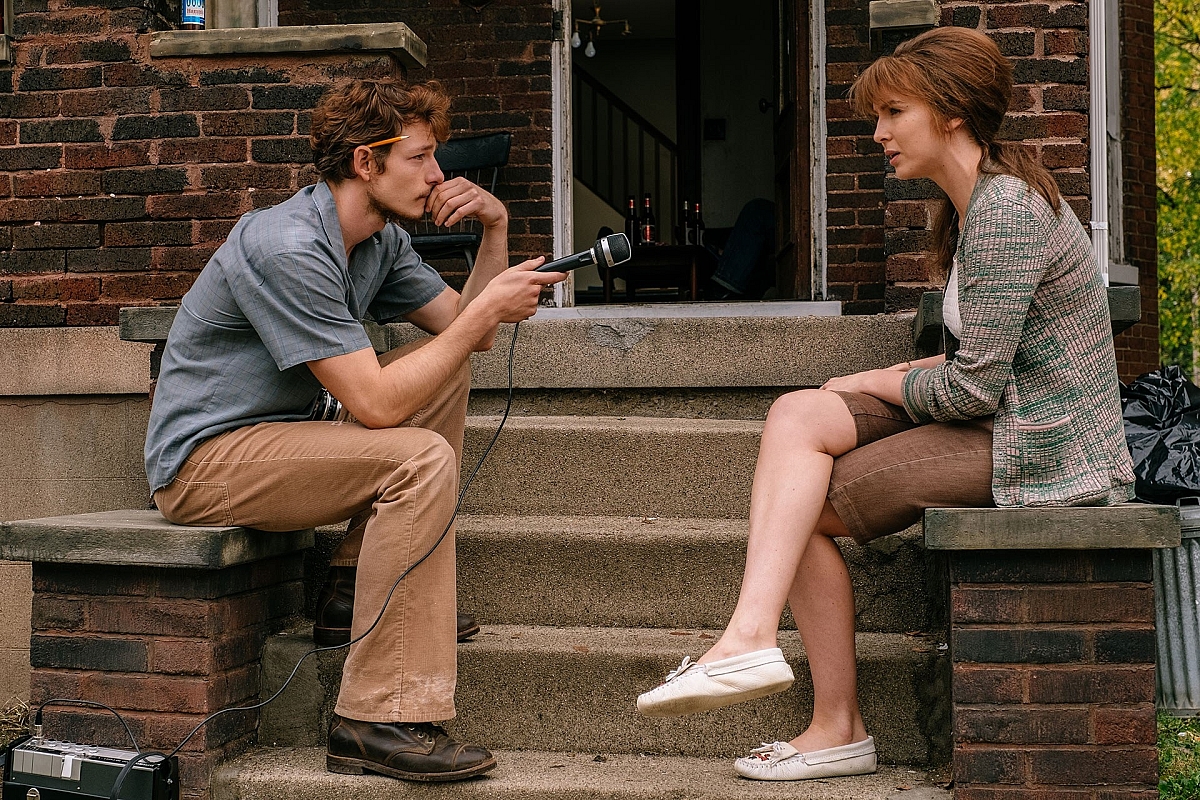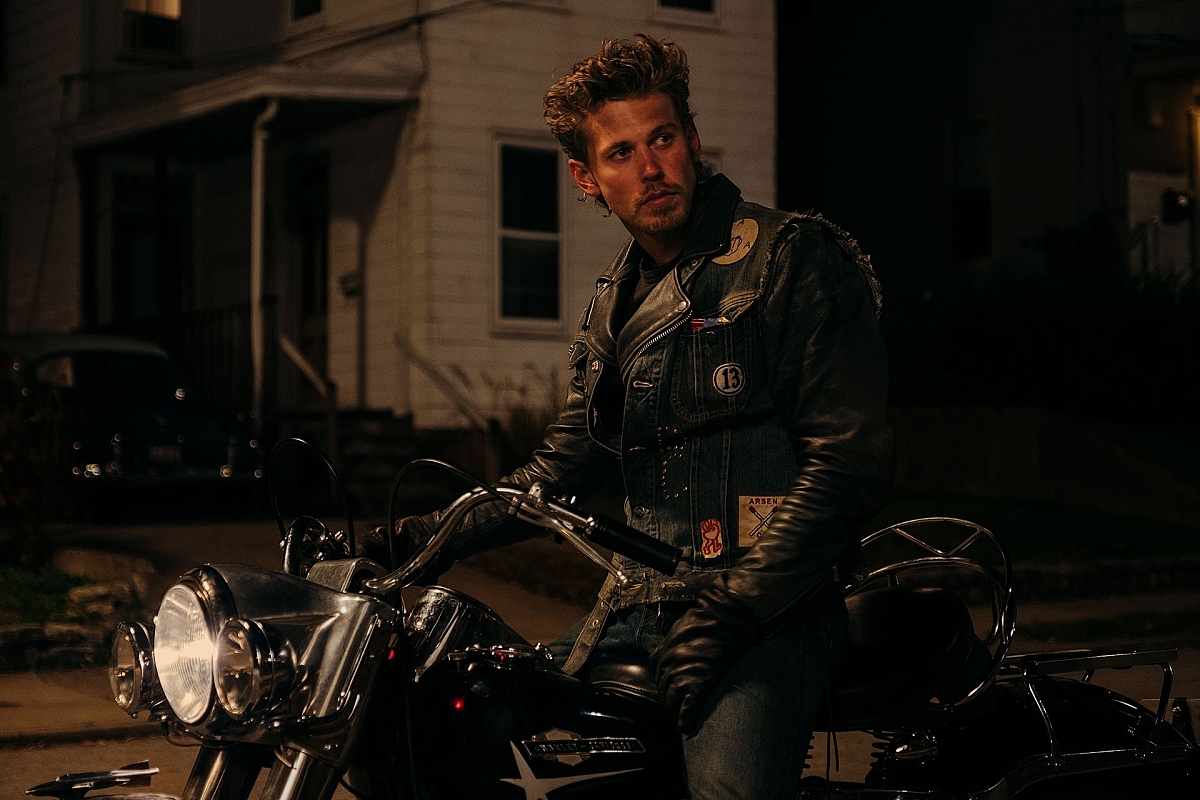Shooting on KODAK 35mm, DP Adam Stone captures the inner life of a close-knit '60s motorcycling gang for director Jeff Nichols' 'The Bikeriders'

Austin Butler as Benny in director Jeff Nichols' THE BIKERIDERS, a Focus Features release. Photo courtesy of Focus Features. © 2024 Focus Features, LLC. All Rights Reserved.
Throbbing engines, petrol fumes, leather jackets, grease and sweat, plus swaggering attitudes towards rebellion and freedom, pervade the story of The Bikeriders, director Jeff Nichols's fictional chronicle of '60s motorcycle club The Vandals.
The film follows Kathy, the girlfriend of brooding bad boy Benny, who finds herself relegated in biker life behind Johnny, Benny's mentor and president of The Vandals. As the club begins to transform from a gathering of local outsiders into a dangerous underworld of violence and criminality, Benny is forced to choose between Kathy and his loyalty to the gang.
The film was inspired by the 1967 black-and-white photo book of the same name, plus audio interviews, made by photojournalist Danny Lyon, depicting the lives of The Outlaws MC, founded in McCook, Illinois in 1935, the oldest outlaw biker club in the world.

(L to R) Director of photography Adam Stone, actor Austin Butler and director Jeff Nichols on the set of THE BIKERIDERS, a Focus Features release. Photo by Kyle Kaplan/Focus Features. © 2024 Focus Features. All Rights Reserved.
Written and directed by Nichols and captured in widescreen Anamorphic on KODAK 35mm film by his longtime cinematographic collaborator DP Adam Stone, the $40 million production stars Jodie Comer as Kathy, Austin Butler as Benny and Tom Hardy as Johnny, alongside Mike Faist as Danny Lyon.
The movie premiered as the opening film of the 2023 Telluride Film Festival and earned critical acclaim for the gritty authenticity of Nichols' direction, its charismatic cast and the sense of place and tone in Stone's cinematography.
"The Bikeriders was a project that Jeff had been incubating for the best part of ten years, although he did not have a script until 2022," says Stone, a contemporary of Nichols at University of North Carolina School of the Arts, who previously filmed the director's Shotgun Stories (2007), Take Shelter (2011), Mud (2012), Midnight Special (2016) and Loving (2016) all on KODAK 35mm as well.

(L to R) Director of photography Adam Stone and director Jeff Nichols on the set of THE BIKERIDERS, a Focus Features release. Photo by Kyle Kaplan/Focus Features. © 2024 Focus Features. All Rights Reserved.
"My start on the project, absorbing Danny Lyon's photo book about The Outlaws MC, was similar to Loving, when we referenced the photojournalistic stills work in Grey Villet's 1965 assignment by Life magazine. We found those images so powerful that they became touchstones for our visual style, and we even reenacted some of those moments in the movie. Similarly, Danny Lyon's book gave us some knock-out Easter egg pictures to work the story around for The Bikeriders."
Stone adds, "One of the first discussions we had was whether this film would be in color or not, as most of the stills in Danny Lyons' book were in black-and-white. While I would love to have filmed this story in black-and-white, Jeff prefers color as he believes it is more accepted by, and holds more interpersonal communication for, the audience."
Although there are plenty of biker movies – such as The Wild One (1953, dir. László Benedek, DP Hal Mohr ASC) and Easy Rider (1969, dir. Dennis Hopper, DPs László Kovács & Baird Bryant) – that the director and DP could have referenced creatively, Stone says, "We found them either super-raw or too glamorous in their visual aesthetics for this story. Our stunt co-coordinator/bike wrangler Jeff Milburn pointed us towards some 16mm biker films that were pretty crazy. We also looked at other dark and subversive photographic stills of biker gangs in California and the mid-West, which told us a lot about the level of dirt under fingernails and the scorched earth bikers left after their camp outs.

(L to R) Austin Butler as Benny and Tom Hardy as Johnny in director Jeff Nichols' THE BIKERIDERS, a Focus Features release. Photo by Kyle Kaplan/Focus Features. © 2024 Focus Features, LLC. All Rights Reserved.
"However, although we had this rich tapestry of visual references, it really was Danny Lyon's book that was the most influential for us and more in our wheelhouse as regards look of the film," explains Stone, adding, "Jeff had copies of the original tape-recorded interviews that Danny made with The Outlaws, which were illuminating to listen to, and those were where Jodie developed the accent for her character, which is absolutely spot on in the film."
When it came to originating The Bikeriders in widescreen on 35mm film, Stone says, "Jeff wanted to tell a simple, unambiguous story and to keep it as authentic and as natural as possible. We have captured all of our films on film in widescreen for the basic reason that it is emotionally evocative and completely captivating.
"This dates back to when we were at film school together, being heavily influenced by the simplicity of style from directors like Terrence Malick and how his gorgeous and mainly location-based films looked on 16mm or 35mm film. I later worked as second unit DP on George Washington (2000, dir. David Gordon Green), also shot on film, but in widescreen Anamorphic, which Jeff loved. We filmed our first feature, Shotgun Stories, on 35mm in Anamorphic and have literally never changed that visual recipe since then."

(L to R) Mike Faist as Danny and Jodie Comer as Kathy in director Jeff Nichols' THE BIKERIDERS. Photo by Kyle Kaplan/Focus Features. © 2024 Focus Features, LLC. All Rights Reserved.
Principal photography began in October 2022, taking in locations around Cincinnati, Ohio, before concluding some 40 shooting days later in December. Stone went with Panavision Panaflex Millennium XL2 35mm cameras, shooting in 2.39:1 aspect ratio in 4-perf on 35mm film, using Panavision G-series Anamorphic as the workhorse optics, supplemented with longer focal length lenses from Panavision's T-series range. The camera and lens package was supplied by Panavision, Woodland Hills, in Los Angeles.
"We've been using the G-series lenses since we shot Mud," says Stone. "They have good contrast and glare resistance, and more controlled aberrations than other Anamorphic glass. For Jeff and me they do a great job of emulating human vision when you are capturing on film, especially the fall-off of skin tones on faces. I also knew I could encourage nice horizontal flares into the image from a motorcycle headlight or other specular source."
Sticking with other known favorites, Stone selected KODAK VISION3 250D Color Negative Film 5207 and KODAK VISION3 500T Color Negative Film 5219 to capture the action. "As with the lenses, the way these stocks render skin tones is what you see with your own eyes, and we've used this exact same combination of KODAK's Daylight and Tungsten filmstocks on our last few films.

Austin Butler stars as Benny in director Jeff Nichols' THE BIKERIDERS, a Focus Features release. Photo courtesy of Focus Features. © 2024 Focus Features, LLC. All Rights Reserved.
"To me, the 250D is the most gorgeous filmstock ever made. It just looks so wonderful on people. I used it as much as possible, even for dark daylight interiors, such as the opening scene when Benny gets ejected from the bar, and later for the scenes in the bar where The Vandals hang out together.
"Obviously, the 500T was my workhorse stock for all of the low-light and nighttime scenarios, and I shot uncorrected, without a filter, as I prefer to do the correction in post. Actually, we don't use any filters, not even polarizers, in front of the lens. And, during this production, everything was exposed normally, no push or pull processing. Everything that we do at the camera is super simple and as basic as you can get, and we let the hair/make-up, costume and production design take us to the time and place."
Film processing and 4K scans were done at FotoKem in Los Angeles before the final grade was completed by Mitch Paulson, senior colorist at Company 3.

Norman Reedus as Funny Sonny in director Jeff Nichols' THE BIKERIDERS, a Focus Features release. Photo by Kyle Kaplan/Focus Features. © 2024 Focus Features, LLC. All Rights Reserved.
During production, Rod Calarco variously operated A-camera and Steadicam, assisted initially on focus by Dylan Conrad, and then by Eric Swanek. When an additional camera was required Kenneth Neil Moore shot B-camera, assisted by Matthew Brewer. Rudy Covarrubias led the grip team, with Michael Roy overseeing the lighting as the gaffer.
"Unless a scene involved multiple characters, such as in The Vandals' bar or during a fight, this was pretty much a single-camera shoot," says Stone. "Since it was based on the work of a documentary photographer, and some of the characters were pretty wild, we introduced a little bit more handheld movement than we've had in most of our previous movies. But we are always reticent about the camera drawing attention to itself and avoid anything too crazy or shaky. For Jeff, the camera's point-of-view is always about being with the characters and observing them in a natural way."
The quest for naturalism was also fundamental to Stone's approach to the lighting. "Before we start production, we try to find environments and locations – whether it's a building, a room, an outdoor landscape – that fit the movie, that will feel real when populated by the actors and will help to tell the story, no matter how complicated or simplistic the lighting requirement may be when we actually come to shoot there – like Kathy and Benny's 10x10-ft bedroom or The Vandals' watering hole.

(L-R): Jodie Comer as Kathy and Austin Butler as Benny in director Jeff Nichols' THE BIKERIDERS, a Focus Features release. Photo courtesy of Focus Features. © 2024 Focus Features, LLC. All Rights Reserved.
"We had a mixture of traditional and LED lights on The Bikeriders. For night exteriors outside The Vandals' bar, we had a couple of 20Ks on lifts, cross-lit to give an appropriate level of illumination and create a great overall look. And on the same set we would typically supplement those with Creamsource Vortex's used as streetlights.
"For the bar interior, which was a naturally very dark location, we extended the push of light through the windows to the back of the bar with ARRI Skypanel 360s. We didn't particularly focus on beauty lighting for our leads, and there was no backlighting. The illumination on them was organic and pretty spartan most of the time, very much in keeping with the rest of the visual storytelling."
Stone remarks that one of the biggest challenges during production was conveying a sense of interpersonal connection between the audience and watching characters riding their motorbikes together en masse.

Toby Wallace stars as The Kid in director Jeff Nichols' THE BIKERIDERS, a Focus Features release. Photo by Kyle Kaplan/Focus Features. © 2024 Focus Features, LLC. All Rights Reserved.
"We used a pursuit arm several times for shooting general bike stunt scenes, but figuring out how to get the camera close-up on the bikers riding closely together in a group took a bit of time," he explains.
"We tried filming with the actors and the camera variously on e-bikes and real bikes, but that didn't work. We had the actors riding trikes while filming with a stabilized camera, but that didn't work either. We tried all sorts of other iterations, before landing on having an actor riding a trike and our camera operator, Dylan, being strapped on to a kind of gangplank on the same vehicle operating handheld shooting with a 40mm lens just three feet away from the talent. That really give an air of authenticity to the sensation of bike riding while capturing faces and expressions."
Looking back at his experience of shooting The Bikeriders, Stone exclaims, "There's a reverence on set when you shoot on film. The actors and the crew realize it's a special artistic medium and everyone has to be on their A-game. Our sets are very civil and pretty quiet. Jeff is honed in on the actors and providing them with a safe place to do what they need to do in front of camera.
"Visually, I love the nuances and naturalism of the filmed aesthetic. It separates your work from other movies, especially digital, and you just know you are creating something distinctive. Film is so special. Hopefully it will be around for a long, long time to come."